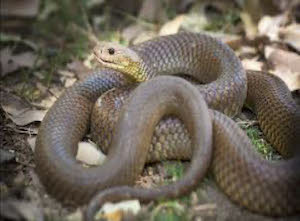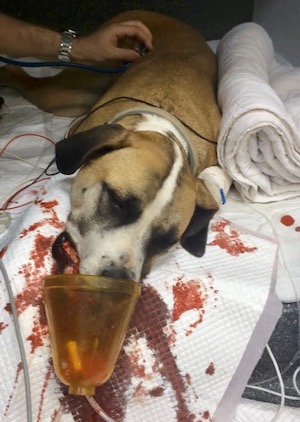Eastern brown snake

Photo courtesy of Animal Emergency Services
The eastern brown is one of many deadly species of snakes found in Australia. Together, they are estimated to bite thousands of pets each year.
Sharing a country with many of the world’s deadliest snake species, Australian veterinarians often have a bite anecdote to share. Some are gruesome; others are lighter, almost amusing.
Dr. Andrew Padula, an envenomation expert from East Gippsland, Victoria, once witnessed a single snake kill three dogs in rapid succession. Multiple fatalities, he says, aren't as rare as one might think.
"A snake will get into a back yard with three Jack Russell terriers, and they start having a go at it," Padula said, as an example. "The snake bites all three, and the owner comes home and finds them all dead or in some very serious trouble."
Dr. Courtney Reddrop, veterinary manager at Animal Emergency Service in Carrara, Queensland, recalls a heartbreaking case involving a pair of Staffordshire bull terriers that tangled with an eastern brown snake.
They made it to the hospital alive but the owner couldn't offer the thousands of dollars needed to treat two dogs, forcing him to make an agonizing choice. "They each needed antivenom but one was put to sleep because he couldn’t afford to save them both," Reddrop said.
Not every encounter ends in tears. Padula had a client whose dog had snakebite-related injuries at least five times. The plucky pooch survived all five encounters. "Virtually every spring, this owner would ring me up and say, 'Oh no, it's happened again,' " Padula recounted. "Patients can bounce back pretty well."
Inconsistency in snakebite outcomes and a tendency to rely on anecdotes to predict them inspired an initiative called SnakeMap, which published its first findings this year. Conceived by Dr. Manuel Boller, a senior emergency and critical care (ECC) lecturer at the University of Melbourne, the project might be the world's first national small animal-snake envenomation registry.
A website featuring an incident "heat map" based on data provided to SnakeMap by dozens of veterinary practices is set to go live in the first half of 2021. The website also will provide snakebite treatment advice for veterinarians.
"There is a very strong need to fill an epidemiological gap when it comes to snake envenomation, given that it's such a huge problem for emergency medicine folks down here," Boller told the VIN News Service.
Understanding 'Big Joe Blake'
Boller, who graduated with a veterinary degree from the University of Zurich in Switzerland, remembers being struck by how little information existed about snakebites when he first arrived Down Under in 2012. The only scientific paper he could find that tried to measure the extent of the problem was published in 1998. Based on responses from 106 veterinary practices surveyed, it estimated that around 6,200 pet dogs and cats combined are reported as being bitten nationwide by snakes — colloquially known as "Big Joe Blakes" — in the country each year.
Boller suspects snakebite incidents are much more common today because Australia's ballooning human population has encroached on the habitats of native venomous species, including brown snakes, tiger snakes, taipans, death adders and red-bellied black snakes. In the warmer months, Padula said, veterinarians in East Gippsland might see one snakebite case almost daily; incidents in the centers of big cities such as Sydney and Melbourne are less frequent.
Snakebite victim

Photo courtesy of Animal Emergency Service
This snakebite victim was treated in the intensive care unit of Animal Emergency Service in Brisbane, Australia. Animals bitten by venomous Australian snakes, such as the eastern brown, can experience rapid and severe internal bleeding.
SnakeMap’s scope is Australia. Boller said veterinarians in other countries with large snake and pet populations, including the United States — home to rattlesnakes and copperheads — could benefit from a similar initiative. (Boller did a residency in veterinary emergency and critical care at the University of Pennsylvania and is a diplomate of the American College of Veterinary Emergency and Critical Care.)
Boller set up SnakeMap in 2015 with epidemiologist Mark Stevenson and fellow ECC specialist Dr. Kylie Keelers. During the past five years, other veterinarians have helped out, including Padula and Reddrop. The project is a labor of love, although funding for the pending SnakeMap website has been provided by the ECC chapter of the Australian and New Zealand College of Veterinary Scientists, a professional peer group.
The first of many planned batches of SnakeMap data was released in August via a report in the Australian Veterinary Journal. Information gathered during the project's first four years shows that 88% of 624 dogs and cats reportedly survived venomous snakebites.
An 88% survival rate is encouraging but the data doesn't tell the whole story, Boller noted, because pets might die before making it to a veterinarian and therefore would not be included in SnakeMap. The research has shown, for example, a greater tendency for animals bitten by brown snakes in southeastern Queensland to experience severe and rapid bleeding in the lungs. Victims might survive if their owner notices the bite quickly. Others could be dead in minutes.
Cats in particular, Boller said, are far more likely to be bitten while hunting away from their homes. According to SnakeMap, just 26% of snakebite cases involving felines occurred in an owner's yard, compared with 85% for dogs. (Cats don't have it all bad, though: Other research shows their bodies can handle snake venom better than dogs.)
Factors that can influence the lethality of bites include the species of snake involved, size of its victim, how much venom was transferred during the bite and where the bite occurred on the victim's body. Bites on the trunk often are more deadly because the venom can travel faster to vital organs. Bites on the head are more common in pets. That location is problematic, Padula laments, because on heads, it is harder to apply pressure-immobilization bandaging that can slow the spread of venom.
Knowing your elapid from your crotale
Snake venom is made up of toxic proteins that can have multiple effects on victims' bodies. The lethality of the toxins can vary among snake species, and even among snakes of the same species. Venomous snakes in Australia commonly are part of the Elapidae family, which includes brown snakes, black snakes and taipans. Common venomous elapids found elsewhere include black mambas in Africa and cobras in India. Clinical signs caused by elapid bites include paralysis, anaphylactic shock and temporary blood clotting, veterinarians told VIN News. Later, victims can appear drowsy and, in worst cases, experience severe internal bleeding that may flow from the mouth.
By comparison, many common venomous snakes in North America, such as rattlesnakes, hail from the Crotalinae family. Their victims are likely to suffer swelling, extreme pain and tissue damage at the bite site. However, Boller and Padula said rattlesnake bites, while potentially deadly, too, aren’t quite as lethal as those from many elapids.
As for snakes of the same species, Redropp, who has practiced on both sides of the Australian continent, said, by way of example, that the venom of eastern browns is much more lethal than that of western browns. "Eastern brown victims can die very, very abruptly from pulmonary hemorrhage," he said. "Whenever you hear a soft cough on a suspected eastern brown snake bite on a dog, you’ve got to get out the ventilator real quick. And we get the antivenom into them as soon as possible, then give them plasma, as well."
Reddrop hopes SnakeMap will arm veterinarians in different geographic areas with a similarly nuanced understanding of the threats their patients face.
Dog breeds most frequently bit
Owners of certain breeds of pet should be warier than others. According to the SnakeMap data, the most commonly bitten breed of dog in Australia is the Staffordshire bull terrier, followed by the Jack Russell terrier. "Some dogs sniff snakes out and chase them, which is why the terriers, which are pretty good at doing that, are so overrepresented," Boller said. "If you look at it from the snake’s point of view, those dogs are a huge threat because they want to kill you."
Bitten dogs, the data showed, were hospitalized for a median duration of 24 hours; for cats, the median duration was 27 hours. Survivors were rarely hospitalized for extended periods. A single cat was hospitalized for more than two weeks, and four dogs for longer than four weeks.
As for the cause of death, 30% of those that did not survive perished due to cardiopulmonary arrest; the rest were euthanized. Veterinarians indicated that financial constraint (51%) and severity of illness (49%) were the primary reasons for euthanasia.
A case for snakebite vaccines?
Treating bitten pets can be expensive. Boller, Padula and Reddrop concurred that antivenom alone can cost a client in Australia at least AU$1,000 (US$760). Add an emergency consultation fee and potential respiration and hospitalization costs, and bills can easily amount to between AU$4,000 and AU$6,000 (US$3,038 to US$4,558) per victim, they said.
A reasonably high proportion of pet owners spring for treatment because the antivenom, if used in a timely manner, is highly effective. "Yes, it costs money, but you get what you paid for in most circumstances," Boller said.
Even so, Padula, in particular, would like to see more research conducted into developing snakebite vaccines.
"If you're in a more remote area where a bite victim might be 45 minutes' drive away … it's not unusual for those to be dead in the car on the way in," he said. "I've dealt with farmers that have repeatedly lost working dogs to snakes on rural properties, and that can be really frustrating for them."
At least one company in the U.S. offers a vaccination for rattlesnake bites; Padula said more detailed scientific studies are needed to confirm its efficacy and safety. Some old studies, he said, including in Australia in the 1960s and Japan in the 1980s, showed that humans can build immunity to snake venom if incrementally exposed. The possibility of vaccinating against snake venom also has been highlighted in popular culture: The famed snake handler Bill Haast and punk rock singer Steve Ludwin both claimed to have built an immunity after exposing themselves to venom hundreds of times each.
Boller notes that conducting sophisticated vaccine trials would be challenging because the lethality of snakebites is determined by a variety of factors. "It’d be really hard to isolate the effect of a treatment," he said. "So you’d need a big sample size and therefore, it would cost a lot of money."
For his part, Padula hopes the ongoing COVID-19 pandemic could provide the veterinary community with a bit of inspiration. "With all this pushing the boundaries with immunization to make new coronavirus vaccines, there may well be some things that the veterinary world could leverage out of that and get a snake-venom vaccine going," he said.